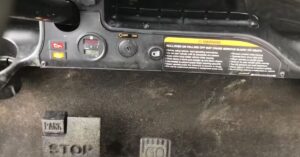How To Put A Golf Cart In Reverse? [Step By Step Guide]
Golf carts are crucial for getting around the golf course, offering convenient transportation for players and staff. While moving forward is easy, reversing the cart can confuse some users.
To put a golf cart in reverse, you will need to: Locate the reverse switch or lever. Then, Move the switch or lever to the “reverse” position. Finally, Press the accelerator pedal to start moving in reverse. Be aware of your surroundings and drive slowly and carefully.
In the following sections of this article, we will explore the steps required to engage the reverse gear on a golf cart, ensuring you have the knowledge to maneuver with ease.
How To Put A Golf Cart In Reverse: Step-By-Step Guide
Golf carts are popular vehicles used for transportation on golf courses and in various recreational settings.
Knowing how to put a golf cart in reverse is an essential skill for maneuvering safely.
Follow this step-by-step guide to learn how to put a golf cart in reverse.
Step 1: Locate the Reverse Switch or Lever
The first step is to locate the reverse switch or lever on the golf cart. The location may vary depending on the make and model of the cart. Typically, the reverse switch is found near the gear selector or on the dashboard.
Step 2: Ensure the Cart is at a Complete Stop
Before engaging in reverse, make sure the golf cart is completely stopped. This ensures the safety of both the occupants and the surroundings.
Ensure that the parking brake is engaged and that the cart is not in motion.
Step 3: Engage the Reverse Switch or Lever
Once the golf cart is stationary, engage the reverse switch or lever. This is usually done by flipping a switch or moving a lever into the “R” (reverse) position.
Some carts may require pressing a button or a combination of buttons to activate the reverse.
Step 4: Check for Indicators
Many golf carts are equipped with indicators or lights that signal when the cart is in reverse.
Look for these indicators on the dashboard or near the gear selector to ensure that the reverse function has been engaged successfully.
Step 5: Release the Parking Brake
After engaging the reverse and confirming the indicators, release the parking brake. This will allow the golf cart to move in reverse.
Step 6: Gradually Apply the Accelerator
Once the parking brake is released, apply gentle pressure to the accelerator pedal.
Start slowly and gradually increase the speed as needed. Be cautious and maintain control while maneuvering the golf cart in reverse.
Step 7: Use Mirrors and Look Behind
While driving in reverse, rely on mirrors and turn your head to look behind you to ensure there are no obstacles or people in the path of the golf cart. This helps to avoid accidents and ensures the safety of everyone around.
Step 8: Practice Safe Reversing Techniques
When reversing, remember to steer carefully and maintain awareness of your surroundings.
Use the same principles as when driving forward, such as signaling your intentions and yielding to pedestrians and other vehicles.
Why Won’t My Gas Golf Cart Reverse?
Gas golf carts can experience reverse function issues due to various causes, including mechanical problems, transmission issues, or electrical system malfunctions.
Identifying the cause and applying the correct solution can restore the cart’s functionality.
Mechanical Issues
If your gas golf cart is unable to reverse, there might be mechanical issues that need attention. Check for the following:
- Loose or damaged reverse linkage: Inspect the linkage between the shift lever and the transmission for any signs of damage or detachment. Tighten or replace the linkage if necessary.
- Worn clutch: A worn clutch can prevent the cart from engaging in reverse. Consult a professional technician to examine and replace the clutch if needed.
- Transmission belt: A worn or damaged transmission belt can hinder the reverse function. Inspect the belt for any signs of wear and replace it if necessary.
Electrical Problems
Sometimes, electrical issues can disrupt the reverse function of a gas golf cart. Consider the following troubleshooting steps:
- Battery voltage
Ensure that the battery is fully charged and in good condition. Low voltage can affect the cart’s performance, including the ability to reverse. Check the battery terminals for corrosion and clean them if needed.
- Solenoid malfunction
The solenoid is responsible for controlling the flow of electricity to the cart’s motor. A faulty solenoid can prevent reverse operation. Test the solenoid using a multimeter and replace it if it’s not functioning correctly.
- Reverse switch
Check the reverse switch for any signs of damage or malfunction. If necessary, replace the switch to restore the reverse function.
Transmission Troubles
In some cases, the problem lies within the transmission system. Here are a few considerations:
- Fluid levels
Ensure that the transmission fluid is at the appropriate level. Low fluid levels can hinder the cart’s ability to engage in reverse.
Refer to the manufacturer’s guidelines for checking and adding transmission fluid.
- Transmission belt adjustment
A misaligned or loose transmission belt can cause issues with reverse operation.
Consult the owner’s manual or seek professional assistance to adjust the belt tension correctly.
- Internal transmission problems
If all other components are in good working order, but the cart still won’t reverse, it’s possible that there are internal issues within the transmission.
In such cases, it’s recommended to consult a professional technician for further diagnosis and repair.
Safety Precautions And Best Practices To Put Golf Cart In Reverse
When operating a golf cart, it is important to follow safety precautions and best practices, especially when putting the cart in reverse.
By adhering to proper procedures, you can minimize the risk of accidents and ensure a safe and enjoyable golfing experience.
Here are some guidelines to consider:
Assess The Surroundings
Before shifting the golf cart into reverse, carefully evaluate your surroundings.
Look for any obstacles, pedestrians, or other vehicles in your path. Ensure the area is clear and safe to proceed.
Check The Mirrors
Take a moment to adjust the mirrors on the golf cart to provide maximum visibility.
Properly positioned mirrors can help you see any potential hazards behind you while reversing.
Engage The Brake
Ensure that the golf cart is fully stopped before shifting into reverse. Apply the brake firmly and hold it down until the cart is securely in reverse gear.
Use Caution And Control
When reversing, proceed slowly and maintain a controlled speed. Sudden movements or excessive acceleration can increase the risk of accidents.
Use gentle pressure on the accelerator pedal to maneuver the cart smoothly.
Look Over Your Shoulder
While using the mirrors is important, it’s also essential to turn your head and look over your shoulder while reversing. This will provide a more comprehensive view of the area behind you.
Use Audible Signals
If your golf cart is equipped with a reverse alarm or horn, use it to alert others of your presence when backing up.
This can help prevent collisions with pedestrians or other vehicles in the vicinity.
Avoid Distractions
When operating a golf cart in reverse, it is crucial to stay focused and avoid distractions.
Keep your attention on the task at hand and refrain from using mobile devices or engaging in other activities that may divert your attention.
Practice Situational Awareness
Always be aware of your surroundings and anticipate potential hazards. Keep an eye out for other golfers, maintenance vehicles, or any other objects that may impede your path while reversing.
Be Mindful Of Passengers
If you have passengers on the golf cart, remind them to remain seated and hold onto the handrails while the cart is in reverse. It is essential to ensure their safety as well.
Regular Maintenance
Maintain your golf cart regularly to ensure it is in optimal condition. Check the brakes, tires, and other components periodically to ensure they are functioning properly, as this can contribute to the safe operation of the cart.
Frequently Asked Questions
Are you having trouble putting your golf cart in reverse? Don’t worry; we’ve got you covered! In this FAQ, we’ll address some common questions related to putting a golf cart in reverse.
Can I Put My Golf Cart in Reverse While It’s Moving Forward?
No, you should never attempt to put your golf cart in reverse while it’s moving forward. Doing so can cause damage to the transmission or other components of the cart. Always bring the cart to a complete stop before shifting into reverse.
What Should I Do if My Golf Cart Jerks or Makes Unusual Noises When Put in Reverse?
If your golf cart jerks or produces strange noises when put in reverse, it may indicate a mechanical issue. It’s advisable to stop using the cart and have it inspected by a qualified technician. Continuing to operate the cart in this condition can lead to further damage or safety hazards.
How Can I Maintain My Golf Cart’s Reverse Function?
Regularly inspect and clean the gear selector mechanism to maintain your golf cart’s reverse function, ensuring it moves smoothly between the different positions. Additionally, keep up with routine maintenance, such as battery checks and lubrication of relevant components, to ensure optimal performance and longevity of the reverse function.
Conclusion
Mastering the skill of putting a golf cart in reverse is crucial for every golfer. Start by locating the reverse switch, firmly press it, and engage the reverse gear.
Remember to look behind you and proceed slowly and safely. Practice makes perfect! Improve your golfing experience today.






![How to Make a Golf Cart Faster? [Top Tips and Modifications] How-To-Make-A-Golf-Cart-Faster](https://giftedgolfers.com/wp-content/uploads/2023/03/How-To-Make-A-Golf-Cart-Faster-300x157.jpg)